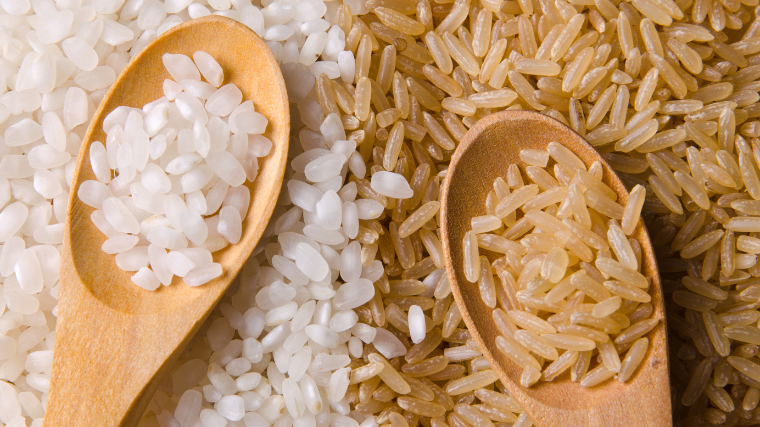The last time you ordered in, you might have been faced with the choice of brown rice or white rice. Brown rice is often marketed as “healthier” while white rice gets a bad rap in certain fitness circles. Yet, white rice has been an important staple for cultures all over the world for at least hundreds of years. So, what is the truth?
Both brown and white rice offer substantial nutritional benefits. But depending on your body and your needs, one may suit you more than the other. It all comes down to what’s in each type of rice, how it’s processed, and what it does in your body after you eat it. Studies also have outlined the possible impact eating the two types have on diabetes and other issues. Read on to learn more about brown versus white rice, and make the best choice for you.
Editor’s Note: The content on BarBend is meant to be informative in nature, but it should not be taken as medical advice. When starting a new training regimen and/or diet, it is always a good idea to consult with a trusted medical professional. We are not a medical resource. The opinions and articles on this site are not intended for use as diagnosis, prevention, and/or treatment of health problems. They are not substitutes for consulting a qualified medical professional.
- What is Brown Rice Vs. White Rice?
- Benefits of Brown Rice
- Benefits of White Rice
- Brown Vs. White Rice Compared
- Which Rice is Right For You?
- Frequently Asked Questions
What is Brown Rice Vs. White Rice?
Rice is a staple food for much of the world’s population, helping to feed nearly four billion people. (1) Rice is a cheap, nutritious way to provide calories and energy. White rice is more widely consumed due to its shelf life and ease of cooking, but brown rice has been found to have higher amounts of fiber, protein and micronutrients. (2)
Rice of any type is a carbohydrate, and both brown and white rice are considered complex carbohydrates. Carbs are a great source of energy. Lifters and athletes of all kinds will likely find themselves eating rice to fuel and recover from their workouts. Brown or white? The choice depends on your goal, body, and needs.
The difference in the nutrient profiles comes down to how rice is processed (or not processed). A whole grain consists of three parts: the endosperm, germ, and bran. The bran contains fiber, and the germ contains vitamins, minerals, and phytonutrients. Brown rice contains all three parts, which makes it “whole.”
On the other hand, white rice has the bran and germ removed during processing. It only contains the endosperm, which has the least amount of nutrients. That makes white rice refined and not a whole grain. (3)
For strength athletes and bodybuilders looking to build mass, both types of rice work for different reasons. For folks looking to lose weight, the diet industry is onto something with brown rice — it’ll keep you full longer. Yet, depending on the individual, there are more factors to consider. We’ll break all these factors down here.
Benefits of Brown Rice
Brown rice is a whole grain packed with nutrients that can be part of a well-balanced, tasty meal and overall diet.
Whole Grain
It’s recommended to consume whole grains in your diet, and brown rice is a great source. There’s been some evidence that a diet rich in whole grains can help prevent type-2 diabetes, cardiovascular disease, and certain cancers. (3)
Nutrient Dense
Brown rice contains more fiber and protein than white rice. It’s also a great source of vitamins, minerals, and flavonoids that function as antioxidants. Some key nutrients located in the germ of brown rice include manganese, magnesium, niacin, phosphorous, vitamin B1, and vitamin B6. (4)
Feel Full Longer
Consuming fiber is an important part of a well-balanced diet. Studies have shown that getting adequate fiber can slow gastric emptying and increase how full you feel. (5) If you’re on a budget or short on time, opting for brown rice over white may help you stay full until your next meal. This is also helpful if your goal is fat loss, to stay satiated by the quality calories and nutrients you’re taking in.
May Improve Metabolic Health
A study showed that whole grain brown rice has a slower gastric emptying rate due to the bran layer. This explains the low glycemic response from brown rice — releasing glucose into your bloodstream slower and more gradually. (6) Brown rice may help to lower blood sugar. (7) Studies have also shown that choosing brown rice over white rice may help reduce risk of type-2 diabetes. (8)
Benefits of White Rice
White rice has been a staple food for much of the world for centuries. Although it gets a bad reputation in diet culture, it still has plenty of its own benefits.
Easier to Digest
White rice is lower in fiber and protein than brown rice. Low-fiber diets are often recommended for folks with gastrointestinal diseases and disorders such as Crohn’s disease, diverticulitis, irritable bowel syndrome, and diarrhea. (9) Lower fiber foods, such as a less complex carb like white rice, are less likely to cause inflammation and may be a better option for those with digestive issues.
Quick Source of Energy
Because white rice has less nutrients and is easier to digest, it also converts more quickly into energy. Though technically still a complex carb, it’s a simpler carb than brown rice, and your body can absorb the nutrients more quickly. (10) This can make it part of a great pre-workout meal.
Part of a Balanced Diet
Sure, white rice may lose out on the nutrients that brown rice has in its refining process. But, you can still gain those nutrients back by adding other foods to your meal and overall diet. You can fill your plate with some extra green veggies to make up for the fiber and antioxidants that brown rice has over white.
Cultural Significance
Many Latin American and Asian cultures have eaten white rice for many, many years. It has cultural significance. Food culture has direct impact on health and well-being — taking emotional and cultural relationships with food into account when forming nutritional advice can yield more sustainable health practices. (11)
Brown Vs. White Rice Compared
When it comes to training, nutrition plays a key role in any fitness goal. Rice is a cost and time efficient staple of a healthy diet. Both brown and white rice can be beneficial — which one you choose just depends on your goal.
For Bodybuilders
White rice is a great option that many athletes choose to fuel their training. Since it digests quickly and is less likely to cause gastrointestinal issues, white rice works well with a pre-workout meal. For a post-workout meal, it helps to repair muscle damage and refill glycogen stores, which is key for building muscle.
Bodybuilders often eat a high protein and carb diet, so brown rice can also be good as a post-workout meal, since you’ll get a little extra protein. The fiber content in brown rice can also be helpful when you’re taking in so much protein. If you choose white rice, you can still get adequate fiber in your diet from other food sources.
For bodybuilders, white and brown rice are both great choices, with white rice possibly being more beneficial at more times of day.
For Strength Athletes
Strength athletes need a lot of energy to fuel hard workouts and move heavy weights. White rice can be a better option for pre-training, since it digests quickly and is available as an energy source for a longer period of time. Brown rice can also work as part of a post-workout meal, providing some extra nutrients to recover from your workout and help you get stronger for your next one.
If you’re a strength athlete, both white and brown rice can work for you. White rice is a bit more time-efficient, so if you’re in a rush to get your post-workout meal in, opting for instant white rice might be more helpful.
For On-the-Go Athletes
If you’re an on-the-go athlete who travels or has a super busy schedule, brown rice may be a better option. Since brown rice digests slowly and is packed with fiber and protein, it will keep you full and fueled for longer than white rice. However, you can also grab some instant white rice to make in a hotel room microwave before a workout. That makes it a good choice for travelers who don’t want to eat all of their meals out.
If you’ve got fitness goals that require you to hit certain macros but don’t have a ton of time for meal prepping, brown rice may be a better option since you can get lots of nutrients in and stay full longer. But, if you’re fueling workouts on the go, white rice is still great for its fast digesting properties.
For Beginners
If you are new to training, tracking macros, and nutrition, it’s best to make small changes to your current diet that you can sustain over time. If your goal is fat loss, you can still enjoy whichever rice you like best, but portion sizes will be key. Brown rice may be a better option if you are tracking calories, since it will keep you full and nourished for a longer time. But if you’re looking to fuel hard and new workouts, white rice can sustain you through them when eaten before.
Both brown and white rice are great options for beginners. Starting a new training regimen will often yield quick results at first, so you want to be sure you are eating enough to fuel your workouts and recover properly.
Which Rice is Right For You?
Should you choose white rice or brown rice? It depends.
Digestive Needs
When you want to figure out which type of rice is best for you, check in with yourself about your digestion. If high fiber foods leave you feeling bloated and uncomfortable, you may want to opt for white rice, since it tends to digest quickly and easily.
If you have no issues in the digestion department, then both types of rice are perfectly fine. But, continue to get more specific with what you want out of your rice.
Fitness Goals
If your current fitness goal is related to fat loss, brown rice is a great option that keeps you full and satiated between meals. If you’re cutting calories in any way, it’s crucial to still get enough nutrients in to keep your body healthy, so brown rice is a quick choice to get extra fiber, protein, vitamins, and minerals.
If you’re looking to fuel tough workouts for hypertrophy or strength, white rice is a great option for pre-workout meals. It digests quickly so you can get to lifting and making those gains. Brown rice can still work for you as well. If you don’t have a lot of time to prepare enough food to get all your nutrients in, get your fiber, protein, and vitamins from brown rice in a post-workout meal.
Personal Preference
A lot of your nutrition choices will come down to personal preferences and needs, too. White rice may be more affordable and accessible in some neighborhoods, especially in cities. You can get it super cheap and make it quickly in the microwave. For that same reason, you might want to opt for brown rice. With brown rice, you can feel fuller longer with more nutritional return on investment.
You may like the taste or texture of one type of rice over the other, which is important to consider when you’re meal prepping. If you have a cultural preference for white rice and you eat it with your family, that’s very important to your health, as well. (11) If you’re concerned about the nutrients, just get more fiber, protein, and antioxidants from other food sources.
Brown Rice or White Rice — Who Wins?
Brown rice and white rice both have health benefits that work well for different folks. To find out which is best for you, get specific about your body, needs, and goals. Both options can be part of a well-balanced diet.
Brown rice will keep you full longer and has more nutrients, but white rice can serve the same purpose if you pack your meals with other sources of those nutrients. Choose your rice, and enjoy your food.
FAQs
Brown rice versus white rice — there are lots of questions around this topic. Let’s dive in.
Does brown rice have arsenic in it?
Studies have found a correlation between rice intake and arsenic exposure. (12) Arsenic is found in the outer layers of the rice grain, which are removed in the processing of white rice, so there may be more of it in brown rice.
Does eating white rice cause type-2 diabetes?
Some studies have shown that a higher consumption of white rice may be linked with an increased risk of type-2 diabetes. (13) However, simply eating white rice will not directly cause diabetes, and it can still be part of a balanced diet.
Which type of rice will help me lose weight?
Both types of rice can help with weight loss. If you’re cutting calories, brown rice will keep you fuller because of its fiber content, and the extra nutrients are good for your body when you’re in a deficit.
Research suggests that it’s more sustainable emotionally and physically to eat food you enjoy to be able to stick with a meal plan instead of focusing on restriction. (14) If you like white rice better, then eating certain portion sizes of white rice can help you enjoy your food and overall stay on track with your nutrition goals.
References
- Lee JS, Sreenivasulu N, Hamilton RS, Kohli A. Brown Rice, a Diet Rich in Health Promoting Properties. J Nutr Sci Vitaminol (Tokyo). 2019;65(Supplement):S26-S28.
- Fukagawa NK, Ziska LH. Rice: Importance for Global Nutrition. J Nutr Sci Vitaminol (Tokyo). 2019;65(Supplement):S2-S3.
- McRae MP. Health Benefits of Dietary Whole Grains: An Umbrella Review of Meta-analyses. J Chiropr Med. 2017 Mar;16(1):10-18.
- Ravichanthiran K, Ma ZF, Zhang H, Cao Y, Wang CW, Muhammad S, Aglago EK, Zhang Y, Jin Y, Pan B. Phytochemical Profile of Brown Rice and Its Nutrigenomic Implications. Antioxidants (Basel). 2018 May 23;7(6):71.
- Salleh SN, Fairus AAH, Zahary MN, Bhaskar Raj N, Mhd Jalil AM. Unravelling the Effects of Soluble Dietary Fibre Supplementation on Energy Intake and Perceived Satiety in Healthy Adults: Evidence from Systematic Review and Meta-Analysis of Randomised-Controlled Trials. Foods. 2019 Jan 6;8(1):15.
- Pletsch EA, Hamaker BR. Brown rice compared to white rice slows gastric emptying in humans. Eur J Clin Nutr. 2018 Mar;72(3):367-373.
- Hu Y, Ding M, Sampson L, Willett WC, Manson JE, Wang M, Rosner B, Hu FB, Sun Q. Intake of whole grain foods and risk of type 2 diabetes: results from three prospective cohort studies. BMJ. 2020 Jul 8;370:m2206.
- Sun Q, Spiegelman D, van Dam RM, Holmes MD, Malik VS, Willett WC, Hu FB. White rice, brown rice, and risk of type 2 diabetes in US men and women. Arch Intern Med. 2010 Jun 14;170(11):961-9.
- Vanhauwaert E, Matthys C, Verdonck L, De Preter V. Low-residue and low-fiber diets in gastrointestinal disease management. Adv Nutr. 2015 Nov 13;6(6):820-7.
- Holesh JE, Aslam S, Martin A. Physiology, Carbohydrates. 2022 Jul 25. In: StatPearls [Internet]. Treasure Island (FL): StatPearls Publishing; 2022 Jan–.
- Mingay E, Hart M, Yoong S, Hure A. Why We Eat the Way We Do: A Call to Consider Food Culture in Public Health Initiatives. Int J Environ Res Public Health. 2021 Nov 15;18(22):11967.
- Davis MA, Signes-Pastor AJ, Argos M, Slaughter F, Pendergrast C, Punshon T, Gossai A, Ahsan H, Karagas MR. Assessment of human dietary exposure to arsenic through rice. Sci Total Environ. 2017 May 15;586:1237-1244.
- Hu EA, Pan A, Malik V, Sun Q. White rice consumption and risk of type 2 diabetes: meta-analysis and systematic review. BMJ. 2012 Mar 15;344:e1454.
- Akkermann K, Hiio K, Villa I, Harro J. Food restriction leads to binge eating dependent upon the effect of the brain-derived neurotrophic factor Val66Met polymorphism. Psychiatry Res. 2011 Jan 30;185(1-2):39-43.
Featured Image: Iasmina Calinciuc / Shutterstock






